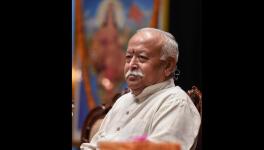An Unequal Music

Image Courtesy: Amazon.in
Journalist Kunal Purohit’s book, H-Pop: The Secretive World of Hindutva Pop Stars, published by Harper Collins India in 2023, examines a burgeoning form of assault on the essential features of democracy in India. It examines the blatant misuse of traditional mass media and other information-sharing platforms and technologies. Fake news, misinformation and disinformation have emerged as worrisome concerns today, hampering the prospects of democratic deliberation. India has become the bright spot of fake news, accompanied by the simultaneous development of a pop culture built around Hindutva, pervasive across the cultural field. “Hindutva Pop” has emerged as a handmaiden of Hindutva and is deployed to propagate its anti-minority logic.
Purohit dives into this understudied field, highlighting the weaponisation of varied elements of mass culture, whose premises promise to widen social divides by expanding its existing fault lines. Kunal travelled across North India, where the political geography has transformed under the Hindu nationalist strain of politics. Starting from Jharkhand, where a song about killing a minority community, played in front of a mosque, turns a Ram Navami procession into a communitarian event. The author painstakingly interrogates the lives of the people who relentlessly produce and propagate this kind of cultural artefact.
Kunal patiently immerses the reader into the life of Kavi Singh, a YouTube performer from Haryana, Kamal Agney, a poet from Uttar Pradesh, and Sandip Deo, an author and YouTuber from Delhi. The trio stands united in the project to disseminate a divisive, hardline, anti-minority message through their art. Serving the ideological principles of Hindutva politics has made their presence on social media noticeable. Indeed, they rely on generating content on their platforms that produces view counts and translates into revenues. Social media has enabled propagandists to tap into audiences on numerous virtual platforms. Success lies in constantly providing these audiences with a regular dose of distorted reality.
The shimmering popularity and wide reception of H-Pop stars showcase the reality of large swathes of today’s India, where hate speeches predominate the public sphere. Research has shown that India leads the origination of anti-Muslim online posts. But there appear to be real-world consequences and triggers: A mosque is demolished, a Muslim is beaten, and a madrasa and century-old library are set ablaze, all during Ram Navami processions. Slowly, the social constitution of India is altered along majoritarian lines. Purohit’s book underscores the forces motivating such incidents.
From propaganda writings that distort or ‘invent’ history to YouTube songs with unconcealed hatred of the ‘other’, to a kavi sammelan [poetry session] laced with lewd speech, efforts to ostracise and unleash targeted verbal assaults on minorities are relentless. Purohit demonstrates how these forces work in tandem with the ruling dispensation and its ideological fountainhead, the Sangh Parivar, to promote everyday communalism. A wounded social fabric can barely resist the violent imageries liberally sprinkled by the right-wing ecosystem. H-Pop is distinctively powerful in its ability to invoke communitarian sentiment through song, poetry or other messages.
Technological advancements and social media allow them a virus-like spread.
A deep-seated hatred against religious minorities remains the primary fodder for their communal appetite, which expands and ensnares institutions and belief systems like Jawaharlal Nehru University, the political left, the Sikhs, farmers, Indian liberalism, and others. All these systems of thought and institutions become the subject of their ridicule and the content of their hate-filled poetry, speeches and songs. The basis for distinguishing what is acceptable is who does or does not pose a challenge to the ruling Bharatiya Janata Party’s politics and policies.
While extensively examining the personal stories of H-Pop stars, Purohit uncovers their anxieties, too. The book painstakingly uncovers the multifaceted realities of these figures, their motivations and why their poetry has gained currency. These stars want to create new patronage networks that proffer inroads into the flourishing lifestyles of Hindutva vanguards. Personal ambition is their guiding force, and it comes at the price of producing increasingly lethal dosages of hate-filled creativity that can garner mass appeal. At times, they yearn for ultra-conservatism, and find the Hindutva practised by figures such as Yogi Adityanath in Uttar Pradesh as their idol and ideal.
The ideological cohesiveness achieved by varied strands of the “digital” Hindu culture accelerates the achievement of the ultimate purpose: To convince the public that polarising society by widening the communal rift is a worthwhile goal. In other words, Hindutva politics is being culturally established via the mechanics of pervasive propaganda. Hate speech, propaganda and fake news are settling in the psyche of a growing section of the citizenry.
Purohit allows us to think about the erosion of minority rights and the status of all marginalised communities. However, he does not document the impact of H-Pop on its consumers—the listeners and viewers of their bewitching and dangerous content.
Tirades of invectives are regularly hurled at the weakest sections of India’s population—its minorities in particular—and the state rarely takes appropriate action. Purohit’s book is timely in that sense, for it intervenes when it is crucial to locate the multivariate sites of communal propaganda production.
The author is a PhD candidate at the Centre for Political Studies, JNU. The views are personal.
Get the latest reports & analysis with people's perspective on Protests, movements & deep analytical videos, discussions of the current affairs in your Telegram app. Subscribe to NewsClick's Telegram channel & get Real-Time updates on stories, as they get published on our website.
























